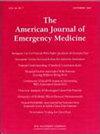Evaluation of limiting PEEP effectiveness in preventing barotrauma in critically ill COVID-19 patients: A retrospective study
IF 2.7
3区 医学
Q1 EMERGENCY MEDICINE
引用次数: 0
Abstract
Background
Severe acute respiratory syndrome coronavirus 2 can cause acute respiratory distress syndrome, requiring prolonged invasive mechanical ventilation. However, patients with coronavirus disease 2019 (COVID-19) undergoing invasive mechanical ventilation experience barotrauma. We assessed whether limiting the maximum positive end-expiratory pressure (PEEP) may prevent barotrauma more effectively than using PEEP/fraction of inspired oxygen (FiO2) in patients with COVID-19 undergoing invasive mechanical ventilation.
Materials and methods
We retrospectively included patients who met the diagnostic criteria at our center; they were divided into an ordinary PEEP group (PEEP/higher FiO2 table) and a limited PEEP group (maximum PEEP of <10 cmH2O) during intensive care unit admission. We evaluated the maximum ventilator variables for mechanical ventilation and limited PEEP to inhibit barotrauma as the primary outcome.
Results
Patients in the ordinary PEEP group (n = 34) were significantly older and had higher body mass indexes than those in the limited PEEP group (n = 27). The maximum PEEP and maximum peak inspiratory pressure were significantly higher in the ordinary PEEP group than in the limited PEEP group. The ordinary PEEP group had a significantly higher incidence of barotrauma than the limited PEEP group.
Conclusions
Limiting the maximum PEEP to <10 cmH2O may prevent barotrauma in patients with COVID-19 undergoing invasive mechanical ventilation.
限制性PEEP在COVID-19危重症患者预防压力创伤中的有效性评价:一项回顾性研究
背景:严重急性呼吸综合征冠状病毒2可引起急性呼吸窘迫综合征,需要长时间有创机械通气。然而,接受有创机械通气的2019冠状病毒病(COVID-19)患者会遭受气压创伤。我们评估了在接受有创机械通气的COVID-19患者中,限制最大呼气末正压(PEEP)是否比使用PEEP/吸入氧分数(FiO2)更有效地预防气压创伤。材料和方法我们回顾性地纳入符合本中心诊断标准的患者;在重症监护病房入院时分为普通PEEP组(PEEP/高FiO2表)和限制PEEP组(最大PEEP为10 cmH2O)。我们评估了机械通气的最大呼吸机变量和限制PEEP以抑制气压创伤作为主要结局。结果普通PEEP组(34例)患者年龄和体质指数均明显高于限制PEEP组(27例)。普通正压组最大正压和最大呼气峰压明显高于限制正压组。普通PEEP组气压创伤发生率明显高于限制PEEP组。结论将最大PEEP限制在10 cmH2O可预防新冠肺炎有创机械通气患者的气压损伤。
本文章由计算机程序翻译,如有差异,请以英文原文为准。
求助全文
约1分钟内获得全文
求助全文
来源期刊
CiteScore
6.00
自引率
5.60%
发文量
730
审稿时长
42 days
期刊介绍:
A distinctive blend of practicality and scholarliness makes the American Journal of Emergency Medicine a key source for information on emergency medical care. Covering all activities concerned with emergency medicine, it is the journal to turn to for information to help increase the ability to understand, recognize and treat emergency conditions. Issues contain clinical articles, case reports, review articles, editorials, international notes, book reviews and more.

 求助内容:
求助内容: 应助结果提醒方式:
应助结果提醒方式:


